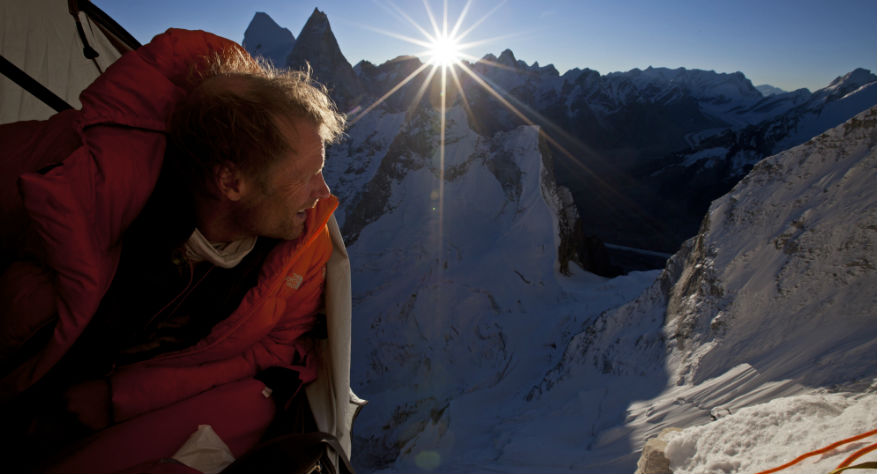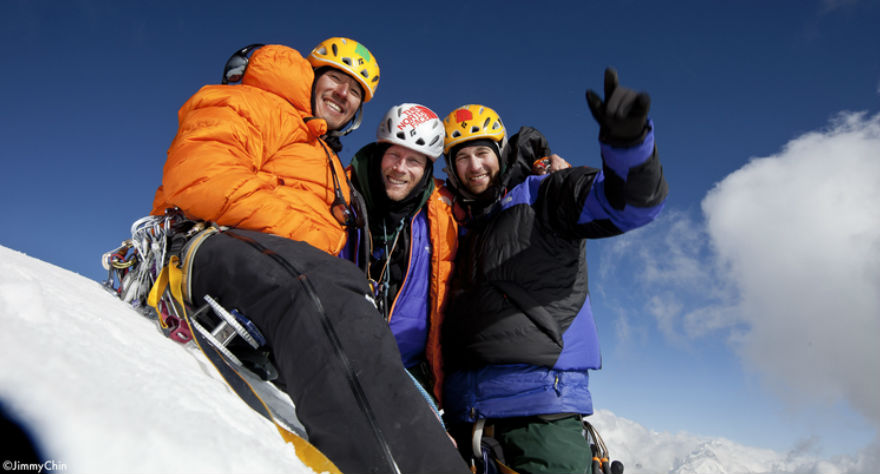‘Meru’ Filmmakers On the Friendship Forged 21,000 Feet In the Air

The “Shark’s Fin” route up Meru Peak in the Indian Himalaya is considered one of the most difficult climbs in the world. Mountaineers Conrad Anker, Jimmy Chin and Renan Ozturk attempted twice to ascend to the 21,000-foot peak (in 2008 and again in 2011), and thankfully for us, they brought cameras with them. Meru is a terrifying, deeply moving documentary about trust, friendship, mentorship, and the fortitude required to conquer one of the most treacherous feats in all of alpinism. Chin directed the film and brought his documentarian wife, E. Chai Vasarhelyi, to co-direct and edit the breathtaking footage. It’s a more personal, human story than the typical mountaineering doc, as it focuses on the bond between the three climbers more than anything else.
I spoke with Jimmy, Chai, and Conrad about their vision for the film, which is out in select theaters this week. For more information on the film, visit merufilm.com

This story definitely falls under the “stranger than fiction” category. I couldn’t believe what I was watching.
Jimmy: I think a lot of people have said something to that effect. They say that you couldn’t write it if you tried.
I’m a film critic who spends a lot of time in front of a computer screen. I could never imagine doing something so bold as what you guys did. What’s different about the way your mind works that allows you to do what you do?
Conrad: Starting out at a young age, you have a successful camping trip. Then you want to do a little more, so you hike to the top of a mountain. Next thing you know, you’ve got ropes and you’re taking trips to Mount Rainier and Alaska and the Himalayas. Each time you build upon the previous experience you get better at it. Eventually, you have a mission like Meru, which was a personal goal for me that was a real treat to share with Jimmy and Renan. I’m honored that Chai and Jimmy and their team made it into a story, because I’m not a filmmaker. [laughs]
Climbing and mountaineering is deeply personal and very intense. We’re playing with fire; people die out there. It’s great to share our passion in a real way that’s not made up. Most mountaineering films are either eye candy—beautiful music, scenic national parks—or people fall off of a mountain and they die. That’s not happening here. It’s about that tension of living a life in society and yet trying to go do something as dangerous as this.
From what I understand the footage wasn’t initially shot with the intention of turning it into a film.
Jimmy: When we started shooting in 2008 we were not planning on making a feature-length film. As a filmmaker, there’s one sort of expedition that’s focused on the production, and there’s another kind of expedition that’s focused on the climbing objective. Meru is a climbing objective-focused trip, so we were just shooting for posterity. In 2011, we went back and shot quite a bit more mostly because of technology. We had better technology to tell our stories with.
Just in three years the tech made that huge leap?
Jimmy: Yeah. That’s when the DSLR revolution happened. It allowed us to have a much more cinematic quality, shooting with such small cameras and such nice lenses. The first moment I thought we might have a feature-length film was during one of the final scenes in the film. I thought it would make a good ending for a film, and that percolated more when you got back to the states.
Talk about constructing the film.
Chai: I only got involved with the film in 2012. I make documentary films, so it was actually quite liberating that they had already shot the mountain footage because I had no control over what was shot. The biggest challenge was structure. The film is about this extraordinary climb, but it’s about so much more. It was about creating emotional arcs in a way that would allow people who weren’t necessarily climbers to have access to the story and develop these themes of mentorship and friendship that are so important. It was a battle in the edit room, but it turned out well.
Tell me more about the master/pupil tradition in mountaineering.
Conrad: Everything we have today is a result of previous generations and what they’ve accomplished and the knowledge they’ve passed on. We’re a sum total of everything that’s come before us, and when you understand that and have someone who takes the best of their knowledge and makes you their understudy, it comes around. Where that introduction came to you, you then pass it on yourself. That was my relationship with Jimmy. It’s enriching for both parties.
Jimmy: I always knew what I wanted the film to say and what the key elements were because that’s what my experience was. I knew that the most powerful experiences I had revolved around this climb and meeting Conrad and having that mentorship. It’s the life I live. Friendship, trust, and partnership are all big parts of climbing. I wanted to make a climbing film that wasn’t a film about climbing. What interests me is everything around climbing.
You use a lot of terminology in the movie that frankly got lost on me because I’m not a climber. But it didn’t matter because, as you said, them movie’s not just about climbing. Were there any difficulties in explaining advanced climbing concepts to a larger audience?
Chai: Of course. I’m not a climber! I had no idea what anyone was talking about. There’s an authenticity to the climbing in the film, which was important to us, but we still explore emotional themes at the same time. The story of Meru is a story of mentorship. Conrad only found this climb through a very special mentorship, and he then shared it with Renan and Jimmy. The stories are so intertwined.
Is it kind of neat to have this amazing experience documented in a way that allows you to reflect and dissect it from a new perspective?
Conrad: I’ve seen the film seven times, and there’s always something new that appeals to me or helps me understand a little better.
There’s a nice little moment when you’re teaching your nephew how to climb, Jimmy. Do you like teaching people like that?
Jimmy: I like when people get excited about anything, really. I like when they show excitement toward an activity. It’s infections and it’s fun. Me and Chai have a daughter, Marina, and Chai says I’m not allowed to take her climbing.
Chai: She’s not going to watch the movie until she’s ready to fight for our country! [laughs] Or until she’s ready to drink.
Conrad: The best female rock climber right now is in the 8th grade.
How?!
Conrad: It’s like gymnastics. The best performers are at that age. There’s a weight to strength ratio. She’s climbing on really small, delicate holds. It’s bolt protected, so risk isn’t a part of it. Imagine climbing is a big tree. Each branch has a different aspect of it, but the commonality is gravity. What we’re doing is Himalayan big wall climbing, so there’s a lot of risk involved. But when it gets too difficult, we put a little nylon ladder down and we inch our way up. A free climber just uses the edges of the mountain. That’s what that girl, Ashima Shiraishi, is doing, climbing at that level of difficulty. So Marina could be right in there!
Chai: No way. [laughs]
I always thought I was too short to be doing stuff like that.
Jimmy: No, no. Ashima is way shorter than me and she climbs way harder than I ever will.
Conrad: Climbing is the most level playing field, gender-wise. The first person to free-climb The Nose at El Capitan was Lynn Hill.
Jimmy: She’s 5’2!
Conrad: I’m 6’2, and height is a disadvantage on certain kinds of climbs. Don’t let your perception fool you. Go to the rock climbing gym and give it a shot and you’ll be psyched. It’s way better than lifting weights because there’s that human aspect. You’re trusting me with your life and I’m trusting you with mine. That’s the beauty of the sport. We’re a team. The adversity is the cliff, the gravity, the weather, the mountain. It’s not three other human beings we have to climb against or keep a ball away from.
What’s the biggest misconception about climbing?
Jimmy: Probably what we just mentioned. The gender thing, that you have to have big muscles or be tall.
Conrad: That we’re thrill seekers and have a death wish. It’s not the case.
Jimmy: There is that misperception that we’re crazy, risk-taking people. Climbing is hyper calculated.
I think a common reaction people may have to this film is that they can’t imagine why you’d do this stuff. Some people may consider you a little crazy for putting your lives at risk like that.
Chai: I think there’s an argument to be made for that. It’s very sophisticated decision-making these guys are doing, but they are risking an awful lot.
Jimmy: The consequences are very real. A goal of ours was to give people a visceral experience of what it’s like to do a climb like that. We’re showing the audience why climbing a mountain is absolutely horrific and miserable and the last thing you’d want to do. But somewhere in the film, if there’s one moment where you might think, “I kind of get it. I see why they would do it.” Did you have a moment like that?
Yeah. It’s when Conrad is sitting by Renan’s bed after he’s badly injured. I understood then that the bond between them is so strong and beautiful that it’d make climbing a mountain worthwhile.
Chai: I love Conrad in that scene.
Right. I think the camaraderie you guys develop and share is something I envy. What have other people said when you ask them that question?
Jimmy: They say different things depending on their interpretation of my question. We kind of set it up for that moment after the portaledge breaks. We’re like, “You know what? We fixed the portaledge; let’s keep climbing.” There’s this montage of us tinkering away and doing our thing. There are moments when you have fun and you’re in awe of where you are. One of the original reasons I started climbing mountains was to be in beautiful places. You get to these incredible locations where you know no one else has been there before. It’s exciting.
What’s going through your head when you do have a second to just take a breath and take a mental picture?
Jimmy: That I should really savor this moment. I’ve been through enough trips where I know when it’s a powerful moment, and there aren’t very many like it.
Conrad: At that moment, you can’t take it in quick enough. It’s so amazing. To be in that location, high up on the peak, looking over everything…you feel like you’re on earth rather than being in a building in a city or something like that. It’s almost like you can feel the earth orbiting.
Jimmy: I’ve equated it to what I imagine it feels like to be in outer space. You feel overwhelmed.
Conrad: It’s an inhospitable environment. Humans aren’t meant to survive there. Unless we bring our tools and our food, we die.
Jimmy: You’re hyper-conscious that you’re in a completely ridiculous place for a human being to be. [laughs] Then there’s the idea where you’re in a space where you can actually enjoy it—there’s an absurdity to it.
